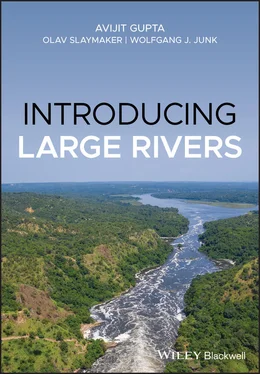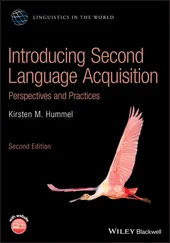The bars occur at several levels related to the frequency of inundation. The higher ones are under vegetation and usually farmed. Sediment transfer varies between seasons. During the dry period, it is confined to deeper sub-channels. During the wet monsoon, sediment travels across the entire channel and occasionally even over the floodplain. Several metres of sediment are scoured from temporary storage on top of the floodplain in high flows (Shukla et al. 1999). The general channel pattern remains the same but the location and geometry of the bars vary over time. The river currently tends to shift only several kilometres within the high cliffs.
The huge Ganga-Brahmaputra Delta is discussed in Chapters 6and 7.
4.5 Morphology of Large Rivers: Commonality and Variations
A review of the morphology and behaviour of the Amazon and Ganga highlights characteristics common to many large rivers. The origin, geographic extension and physical characteristics for many depend primarily on plate tectonics. Certain large rivers have existed for a long time, and most of them reflect repeated changes they have undergone during the Quaternary, concerning the geography of their basins and nature of their course. Regional structural features such as an arching bedrock underneath the channel alluvium or a network of faults modify the general characteristics for the river flowing over such structural features. Large rivers commonly consist of a number of reaches of variable morphology longitudinally assembled to form a big river. Smaller rivers, in contrast, tend to be monotonic in nature (Lewin and Ashworth 2014).
All large rivers are maintained by a large volume of precipitation falling on their basins, at least over a significant part of them. The precipitation can be uniform or seasonal. Given the large size of their basins, large-scale climatic variations such as the ENSO are related to fluctuations in discharge. Such fluctuations may bring in both dry and wet periods. Floods tend to occur in the wet years and from cyclonic disturbances.
Most of the sediment load comes from the high mountains and travels downstream in stages, interrupted by periods of storage in floodplains, on bars, and on bed. As a result, the sediment of a long river becomes progressively enriched in quartz grains and demonstrates textural sorting along the river, the modal class being medium and fine quartz sand. Where tributaries carrying coarse sediment join the main river, local coarsening of the bed material happens for a short distance immediately downstream of the confluence.
Morphologically a large river includes a channel, floodplain, and probably terrace fragments. The channel pattern depends on the gradient of the river and nature of water and sediment as described for both the Amazon and Ganga. Storage and transfer of a large amount of sediment gives a braided appearance to the river, especially in the dry season. The nature of the bars depends on the width and depth of the river. A wide river with braid bars in the dry season may change its appearance in the wet season to a meandering pattern with point bars and lateral bars. During a flood, water and sediment of the river may move laterally, building up the floodplain, as in the Amazon. Sediment in other big rivers may be stored in the same way, and later, after localised erosion of the floodplain and banks of various channels, it is transferred downstream.
Dietrich et al. (1999) described the deposition of the floodplain of the Fly River in the wet equatorial hilly environment of Papua New Guinea. They mentioned three processes of lateral transfer of sediment-laden water into the floodplain: advection of sediment with overland flow when the river is high and the level of water in the floodplain low; lateral diffusion from the sediment-rich water of the river; sediment-laden water travelling upstream into tributaries or small floodplain channels. Sediment is stored for a time in the floodplains of large rivers prior to their erosion and transfer.
On rock, large rivers look and behave differently as their slopes steepen and their courses often follow structural lineations. Their velocity is higher, fewer bars are deposited in the channel, and if they are, they tend to occur near banks or boulder protrusions. Fans occur at tributary mouths, and given the location such fans and bars that evolve from them are built by coarse sediment contributed by tributaries and organised by floods of the main river. Given their length, large rivers may pass through rocky gorges between reaches in alluvium, displaying changing morphology.
The Irrawaddy provides good illustrations. South of Myitkyina, the Irrawaddy is an alluvial river about 1600 km from the Bay of Bengal. Its downstream passage as a low-gradient alluvial river is interrupted by three steep gorges in Palaeozoic rocks. It is a freely meandering river in alluvium south of Myitkyina with a number of abandoned channels and oxbow lakes in the floodplain. The river is nearly 1 km wide when it enters it first gorge which is 56 km long, locally narrows to 50 m, and is tortuous with sharp bends, pools and rapids. The river widens below the gorge and this section in alluvium displays meanders, abandoned channels and bars. Further downstream, below Bhamo, the Irrawaddy turns west to enter the second gorge to cross an upland area before the next alluvial reach where the river returns to its wide meandering course skirting the Gangaw Ranges. This part of the river is flowing in a very wide floodplain with numerous abandoned channels. Numerous bars and islands occur in the main channel, indicating both storage and transport of a large volume of sediment.
Figure 4.9shows the transition of the Irrawaddy from this alluvial section to the third gorge where the river takes a straight course along the Sagaing Fault. The effect of increased gradient and stream power on the transporting capacity of the river is clearly visible. The gorge is confined in steep forested hillsides, and sand bars occur in the channel next to the banks. Downstream, where the river emerges from the gorge, it changes back to a wide, meandering course along a floodplain of active deposition. Striking alterations occur thus in large rivers as their local environment changes. The Salween flows almost entirely in 1000 m gorges cut into plateaux and mountains and its morphology is different from a large river in alluvium. The morphology and channel material of the Mekong changes several times along its course adjusting to local geology and structure (see Chapter 10). The river is free to move only for the last several hundred kilometres in alluvium.
The basic characteristics of the morphology of large rivers are:
1 A large river simply is a river with impressive dimensions. It may have a channel, even 10–20 km wide at high stage and 30–40 m deep in places. Even deeper scours have been measured, especially at confluences with tributaries. Satellite imagery is an appropriate tool for observing the channel at this scale, for measuring kilometre-scale bends and bars, etc. Figure 4.9 Diagrammatic sketch of the Irrawaddy leaving an alluvial segment to enter a rocky gorge along the Sagaing Fault. Scale approximate. Interpreted from SPOT image on the web and topographical maps.Source: Gupta 2005.Sarkar et al. (2014) derived the following hydraulic relationships for the Jamuna River in Bangladesh in alluviumwhere W = average width (m), D = average depth (m) and Qf = annual average flood (m3 s−1). With a rising stage, the Jamuna gets wider rather than deeper with associated morphological changes in the channel.Large rivers can also be bedrock-constricted or wide when crossing alluvial basins. They may be naturally composite, as reflected in their form and behaviour (see Chapter 7).
2 Large rivers display low-intensity planforms. Traditionally, channel patterns are classified as straight, meandering, braided, and anastomosing. The terms anabranching or wandering have been used instead of anastomosing, but in general all three terms refer to a river divided into multiple channels by one or several semi-stationary bars or islands. These channels and bars or islands, unlike in a braided river, are not particularly mobile. These planform terms have been further subclassified to describe a particular river but such practices may lead to considerable confusion. Confusion also arises as a river can meander or braid over a short distance but because of its low sinuosity, it appears to be anastomosing over a longer stretch. Furthermore, rivers in seasonal climate may rise considerably in the wet season, and then appear to present a different planform. The Brahmaputra has been reported to rise 8 m (Coleman 1969; Baker and Costa 1987), and the Amazon 12 m (Archer 2005). The channel pattern of large rivers therefore may look different between the wet and dry seasons. The wet season river tends to display less sinuosity.
Читать дальше












